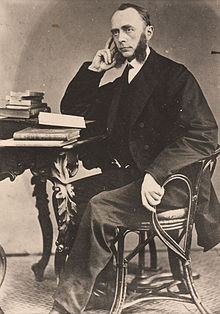Tiberius Winkler
| Tiberius Cornelis Winkler | |
|---|---|
 |
|
| Born |
May 28, 1822 Leeuwarden, Netherlands |
| Died | April 4, 1897 (aged 74) Haarlem, Netherlands |
| Residence |
|
| Nationality |
|
| Known for |
Dutch translation of Darwin's Origin of Species (1860) popular science |
| Scientific career | |
| Fields | Medicine, Paleontology, Zoology |
| Institutions | Teylers Museum |
Tiberius Cornelis Winkler (May 28, 1822 – April 4, 1897) was a Dutch anatomist, zoologist and natural historian, and the second curator of geology, paleontology and mineralogy at Teylers Museum in Haarlem. Besides translating the first edition of Charles Darwin's Origin of Species (1860), he wrote a great number of works popularising science, particularly the life sciences.
Winkler was born in 1822, in the Frisian capital of Leeuwarden. There, he attended primary school until his 12th or 13th year. His father subsequently arranged his apprenticeship to a grain merchant. He used his wages to educate himself in French, then German, and then English. This desire for self-education and self-discipline would characterise Winkler throughout his life.
He married in 1844 and began to study medicine in order to become a surgeon. In 1850, Winkler moved to Haarlem with his wife and four children, to begin his education at the local surgeons' college. He graduated two years later, and set up practice in Nieuwediep. His first patient, a fisherman, complained of being stung by a weever fish. His studies took him to the library of Teylers Museum in Haarlem, and his subsequent article on the weever in the popular journal Album der Natuur established him as an expert on fishes.
At the Museum, he also developed an interest in paleontology and geology. The curator, professor Van Breda, approached him to describe the fossil fishes from his own and Teylers' collections. This set Winkler up at the museum and his work, duly lauded, was published in the Verhandelingen ('Transactions') of Teylers' Society in 1859. This was followed up by further work on fishes from the German Solnhofen limestone, and completion of the catalogue of the museum's fossil fish collection.
...
Wikipedia
